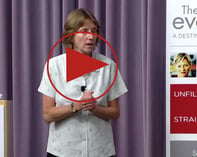Published on
VIDEO | Continuing Ed: The Bridge Builders Connecting Institutions With Employers and the Future
This trailer highlights some of the interesting ideas and innovative insights shared by all three speakers at The EvoLLLution Symposium on Higher Education and the Workforce, hosted at Stanford University. To watch the full video, please click here.
Today I’m going to be talking about a perception gap. It’s an emerging topic in our country and it’s a perception gap that hits corporations and higher learning institutions. Specifically, the perception gap is around work preparedness.
An interesting poll just came out — the 2014 Gallup poll — and in that poll, 11 percent of corporations said [recent graduates] are not prepared for the workforce. On the other side you have higher ed leaders actually showcasing that they’re doing a great job. Ninety-six percent of all chief academic officers are saying, “We’re doing a good job. Your investment is good.” This is a remarkable finding, especially when you think that students are investing thousands of dollars and the effort to go through school.
And then students have to kneel down, go to the altar and beg, “God, please let me get into this institution — this cathedral of learning — because that’s my ticket. It’s the Wonka ticket. Only then will I go on to be successful in life.” Corporations should also have just as much alarm, because they’re relying on institutions; higher learning institutions are the pipeline for the future.
Something is really going on here when we look in the mirror. If I’m higher education, I’m looking good, and I’m going to give myself an A+. And in that same mirror, someone beside me is looking and saying, “Oh no, you’ve got it all wrong. I’m giving you an F.”
If we’re preparing our workforce for the 21st century, we’ve got a problem. President Barack Obama recently said that workforce preparedness through education [is the pathway] to get the jobs of the 21st century. And, more importantly, it’s a way to rebuild our middle class.
So where do we go from here?
For too long we’ve been second. Not because we were put there, but because sometimes we’ve placed ourselves there. Today, as continuing education folks, we have an opportunity to flip the equation. It starts with us having a voice in starting our own rankings. The model is traditional, it’s outdated; it was built on an outdated time. It’s not just about research and federal dollars. It’s more than that. It’s about work preparedness.
To move forward from this model, we need to know one thing. Higher education institutions may rank themselves well at job placement, but that doesn’t mean [students are] prepared for the job.
We have the power to start looking at what the criteria of [workforce preparedness] is, working with our stakeholders in industry. It’s equally important the investment we make in our tax dollars, our household income, that all the other folks in our region, in the community we serve, know the money we spend is getting the maximum ROI.
The lifelong business of learning means we start before [students] get to college and we [may] get them for the rest of their lifetime.
We are, in continuing education, bridge builders. We know how to connect to corporations.
When all these things are going on and we don’t have any money, who are [institutions] turning to? Continuing education. Why? Because they know how to run things on a leaner budget, they know how to get results and they’re business minded. They actually know how to connect to industry. They’re bridge builders.
When you get to college the fact of the matter is, the traditional model is not working. Right now, there’s $864 billion in student debt and $124 million just in private loans. We strapped so much debt onto students, they came out, they wanted to live the American dream. Well, the American dream has changed because it was built on an old model. This is an American problem because it’s an economic and a workforce problem.
This leads me to the next concept of STEAM (Science, Technology, Engineering, Arts, Math), of collaboration, [of left brain/right brain.] Right brain is messy by design. It’s crazy, it’s where love happens, it’s about thinking about possibilities. In fact the original STEM principle was based on an engineer, but an engineer not by training, Leonardo Da Vinci. He was a naturalist, he went out and looked at nature and said, “How can I apply these principles in a way that transfers knowledge into the workplace?”
The thing that comes along with mixing arts with STEM is that solving problem means collaboration. Today, collaboration is a way in which we can look at better innovations in working politically from right to left and it also is a way we can bridge continuing education with higher education.
There are a lot of lessons we can learn from continuing education. We are bridge builders. We need to flip the equation. We need to think about moving from STEM to STEAM. We have the opportunity to go beyond thinking we’re just second to anybody. We are the leaders, we get the students for the rest of their lifetime, and we lend them to higher education institutions. Together, harmony occurs and we’re making a better workforce for tomorrow.
This presentation has been edited for length.
Edward Abeyta was the third of three speakers at The EvoLLLution’s Symposium on Higher Education and the Workforce, hosted by Stanford University. The Symposium featured three snapshot talks by people on very different ends of the higher education-workforce divide (an employer, a student and an administrator), sharing their perspectives on how to close the gap between these two spaces. Over the past month, we published the talks by Maggie Johnson, Director for University Relations at Google and Heather Adams, a former student and the developer and coordinator of UCLA’s Transfer Program.
The above trailer provides a small taste of the innovative ideas and insights shared The EvoLLLution Symposium on Higher Education and the Workforce. To watch the full event and hear all three speakers, please click here:
| WATCH FULL PRESENTATION |
Author Perspective: Administrator



